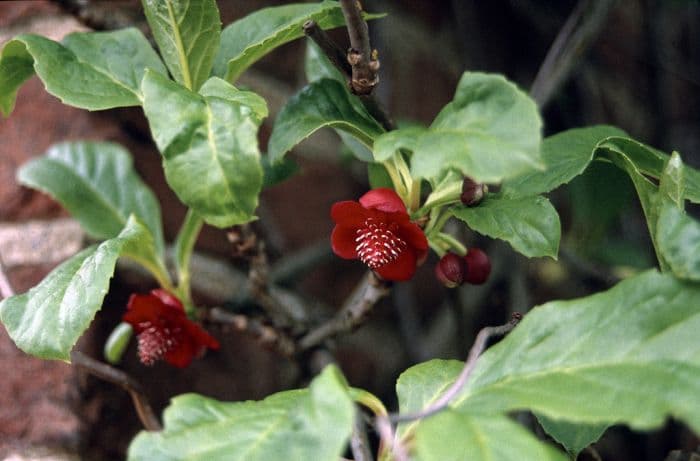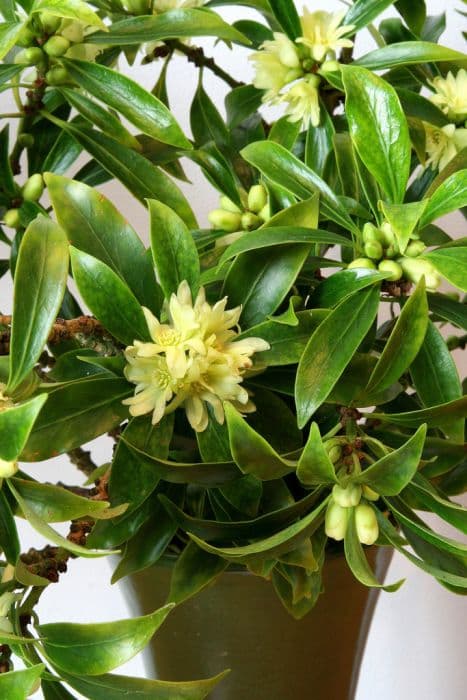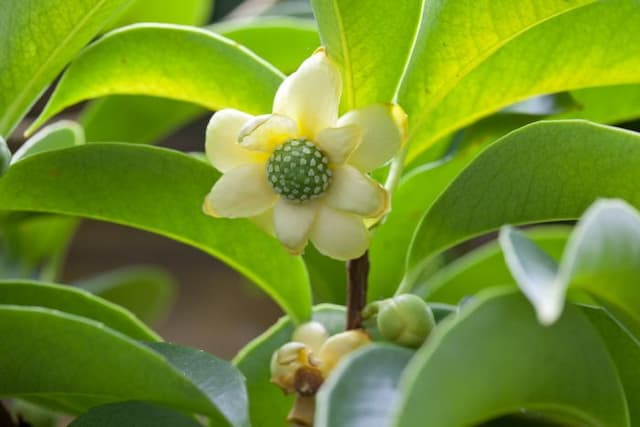Red flowered schisandra Schisandra rubriflora

ABOUT
The Schisandra rubriflora, commonly known as Red-flowered Magnolia Vine, is adorned with a lush, green foliage that creates a dense backdrop for its striking reddish-pink flowers. The leaves are oval-shaped with a glossy finish and a pointed tip, forming an alternating pattern along the slender, woody stems. These stems twine and climb, supporting the plant's growth habit. When in bloom, the Red-flowered Magnolia Vine is particularly noticeable for its clusters of small, fragrant flowers that boast vibrant colors ranging from deep pink to a red hue, adding a splash of color to its surroundings. The petals are delicate, with a slightly waxy texture, and they radiate from the center of the flower in a star-shaped pattern. Following the flowering season, the plant produces a berry-like fruit that is quite attractive. The fruits are rounded and initially green, turning to a more reddish tone as they mature. These berries can add ornamental interest to the vine even after the flowers have faded. Overall, the visual appeal of the Red-flowered Magnolia Vine is a combination of its graceful climbing habit, its lush, vibrant leaves, the bright pop of color from its flowers, and the seasonal interest provided by its fruit. This makes it a cherished plant for gardeners looking to add both color and vertical interest to their gardens without discussing its specific dimensions.
About this plant
 Names
NamesFamily
Schisandraceae
Synonyms
Red Flowered Schisandra, Red Schisandra
Common names
Schisandra rubriflora
 Toxicity
ToxicityTo humans
Schisandra rubriflora, commonly known as Chinese magnolia vine, is not widely recognized for being toxic to humans. There is little information suggesting that the fruit, seeds, or other parts of this plant cause any significant toxicity when ingested by humans. Typically, Schisandra species are used in traditional medicine and are known for their potential health benefits rather than being harmful. As with any plant, individuals may experience varying degrees of sensitivity, and it's always a good idea to exercise caution and avoid ingesting parts of any plant unless it is known to be safe and if you're knowledgeable about its use.
To pets
Schisandra rubriflora, known as Chinese magnolia vine, has no widespread documentation of toxicity to pets such as dogs and cats. It is not commonly listed among the plants that are known to be poisonous to pets. However, pet owners should always be cautious with plants that are not identified as safe for pets, as individual animals may have different sensitivities, and what is non-toxic for humans can sometimes be harmful to pets. If a pet does ingest part of a Schisandra rubriflora and shows any signs of illness, it is essential to contact a veterinarian. Symptoms of plant poisoning in pets can include vomiting, diarrhea, lethargy, or more severe signs depending on the specific toxic compound and the amount ingested.
 Characteristics
CharacteristicsLife cycle
Perennials
Foliage type
Deciduous
Color of leaves
Green
Flower color
Red
Height
10-20 feet (3-6 meters)
Spread
6-8 feet (1.8-2.4 meters)
Plant type
Climber
Hardiness zones
6
Native area
China
Benefits
 General Benefits
General Benefits- Ornamental Value: Schisandra rubriflora is known for its decorative red flowers which enhance the aesthetic appeal of gardens.
- Wildlife Attraction: Its flowers attract various pollinators, supporting local ecosystems.
- Cultural Significance: In some cultures, the plant may have symbolic meanings and is used in traditional festivities.
- Fragrance: The flowers can emit a pleasant scent that contributes to sensory garden experiences.
- Culinary Use: Parts of the plant are sometimes used in culinary applications to add flavor to dishes.
 Medical Properties
Medical PropertiesThis plant is not used for medical purposes.
 Air-purifying Qualities
Air-purifying QualitiesThis plant is not specifically known for air purifying qualities.
 Other Uses
Other Uses- Natural dye: Schisandra rubriflora can be used to extract natural dyes for fabric due to its colored berries and flowers.
- Aromatic oil: The plant may be distilled to produce aromatic oils, which can be used in perfumery or aromatherapy to provide a unique scent.
- Gardening: With its attractive red flowers, Schisandra rubriflora can be used ornamentally to enhance the visual appeal of gardens and landscapes.
- Floral arrangements: The bright flowers of Schisandra rubriflora can be used in floral arrangements as an exotic and colorful addition.
- Bee forage: The plant can serve as a nectar source for bees and other pollinators, promoting biodiversity in the area.
- Edible fruit: While not commonly consumed, the fruit of Schisandra rubriflora may be used in small quantities to make unique jams or jellies.
- Bonsai: The plant's distinctive look and ability to be pruned make it suitable for bonsai cultivation for enthusiasts.
- Educational resource: Schisandra rubriflora can be used in educational settings such as botanical gardens to teach about plant diversity and botany.
- Cultural ceremonies: In some cultures, the plant might be used in ceremonial or celebratory events as decorations or symbolic offerings.
- Wildlife habitat: The plant can provide shelter and food for birds, contributing to the maintenance of local wildlife populations.
Interesting Facts
 Feng Shui
Feng ShuiThe Schisandra rubriflora is not used in Feng Shui practice.
 Zodiac Sign Compitability
Zodiac Sign CompitabilityThe Schisandra rubriflora is not used in astrology practice.
 Plant Symbolism
Plant Symbolism- Endurance - Schisandra rubriflora is known for its ability to survive in harsh climates and poor soil, symbolizing the human capacity to endure challenging conditions.
- Balance - With its combination of five different flavors found in its berries, this plant represents harmony and balance in life.
- Vitality - Schisandra is often used in traditional medicine to boost energy levels and improve overall vitality, making it a symbol of life and vigor.
- Healing - Due to its numerous health benefits, Schisandra symbolizes healing and the restoration of health.
- Mental Clarity - The use of Schisandra in improving mental functions makes it symbolic of clarity, focus, and concentration.
 Water
WaterThe Chinese Magnolia Vine requires consistent moisture, so it's best to water it deeply every week with about 1-2 gallons of water, depending on the size of the plant and the weather conditions. It's crucial to keep the soil moist but not waterlogged. In the hot summer months, check the soil more frequently as it may require additional watering to maintain moisture. During the winter, you can reduce watering as the plant's growth slows down.
 Light
LightThe Chinese Magnolia Vine prefers a spot that gets partial shade to full sun. It can tolerate direct sunlight but thrives best with morning sun and afternoon shade, especially in hotter climates. A location that receives about 4-6 hours of sunlight is ideal for this plant to grow well.
 Temperature
TemperatureThe Chinese Magnolia Vine can survive a range of temperatures but prefers a cooler climate; it can withstand minimum winter temperatures down to 5°F. The ideal temperature conditions for active growth are between 60°F and 75°F. It's essential to protect the plant from harsh winter winds if temperatures drop below this range.
 Pruning
PruningPruning the Chinese Magnolia Vine is essential to maintain its shape, encourage airflow, and promote healthy growth. It's best to prune in late winter or early spring before new growth starts. Remove any dead, damaged, or overcrowded branches. Light pruning can be done throughout the growing season to shape the vine as desired.
 Cleaning
CleaningAs needed
 Soil
SoilFor Red-flowered Schisandra, the best soil mix is well-draining, rich in organic matter, and has a pH of around 5.5 to 6.5. A mix containing peat, loam, and perlite or pine bark is suitable to maintain the necessary drainage and aeration.
 Repotting
RepottingRed-flowered Schisandra should be repotted every 2 to 3 years or when the roots fill the pot. It's best done in spring before the new growth starts, using a slightly larger container each time.
 Humidity & Misting
Humidity & MistingRed-flowered Schisandra thrives best in high humidity conditions, ideally around 60-70%. Maintaining this level of humidity will support its growth and health.
 Suitable locations
Suitable locationsIndoor
Place Red-flowered Schisandra in bright, indirect light with high humidity.
Outdoor
Grow Red-flowered Schisandra in partial shade, sheltered from wind.
Hardiness zone
4-8 USDA
 Life cycle
Life cycleSchisandra rubriflora, also known as red flower magnolia vine, begins its life cycle as a seed, which, when sowed and subjected to the right conditions, germinates and sprouts into a seedling. The seedling grows into a juvenile vine through a process that involves the development of roots, stems, and leaves, essential for photosynthesis and nutrient uptake. As the plant matures, it enters a phase of vegetative growth, during which it increases in size and develops the structures necessary for reproduction. Once mature enough, Schisandra rubriflora produces flowers, typically in the spring or early summer, which are pollinated by wind or insects, leading to the formation of berries. These berries contain seeds, which, when dispersed, can give rise to new plants, thus completing the life cycle. The plant then continues to grow and can live for many years, flowering and producing seeds annually.
 Propogation
PropogationPropogation time
Spring to Summer
Schisandra rubriflora, commonly known as Chinese Magnolia vine, can be propagated effectively through the method of seed sowing. The best time for this is in the fall, after the fruits have ripened and seeds are freshly harvested. Seeds should be sown immediately as their viability decreases with storage. It's important to sow them in a well-draining seed starting mix, placing them at a depth of about 1/4 inch (0.6 cm). The seeds require consistent moisture and a period of cold stratification to break dormancy which naturally occurs during the winter. Once the temperatures rise in the spring, the seeds will begin to germinate. It is essential to keep the young seedlings well-watered and protected from extreme conditions until they are strong enough to be transplanted to their permanent location.

